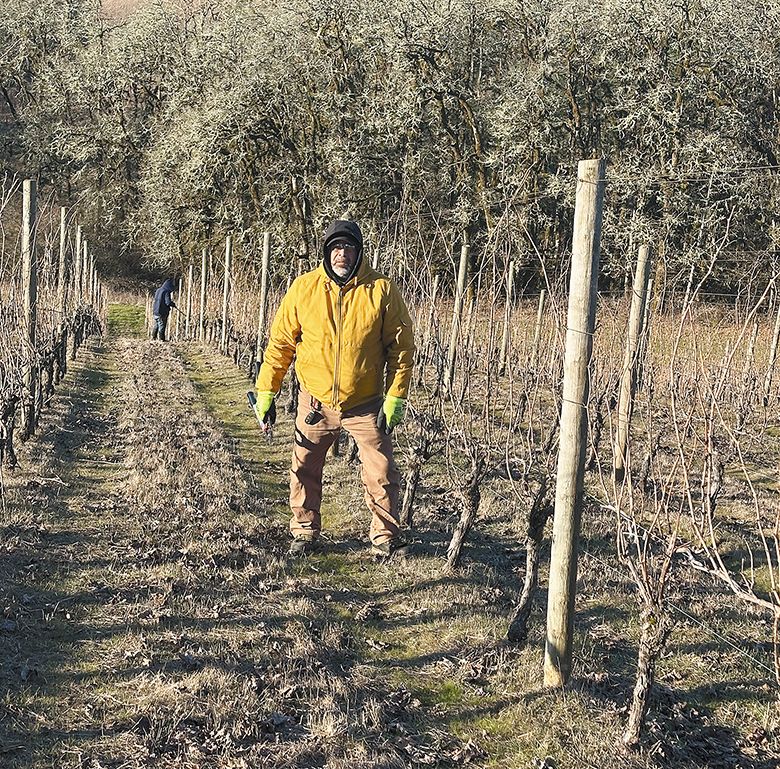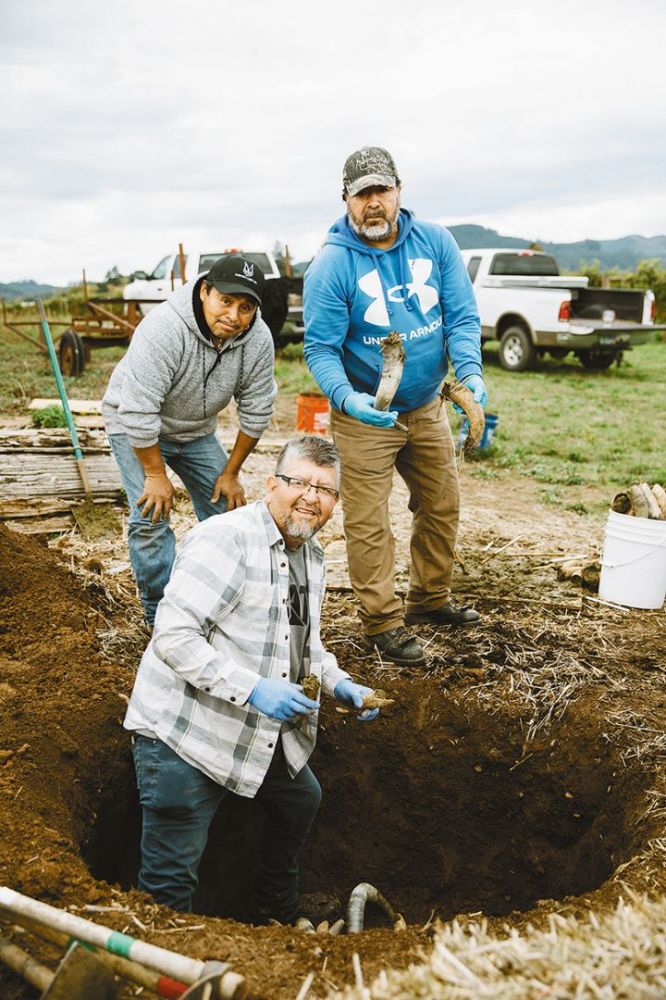Maestro of Montinore
Celebrating 40 years of vineyard stewardship


This new series, Voices from the Vineyard, celebrates Oregon’s vineyard stewards by highlighting their talent, skills, dedication and hard work.
By Annelise Kelly
Winemaking is a team sport.
While winemakers tend to attract the spotlight, let’s never forget how much they depend on other team members. Dedicated agricultural workers spend much of the year pruning and maintaining vines to maximize production along with the annual urgency of harvesting and crushing. Bottling wine also demands a group effort. These workers and their contributions matter.
“There’s been an evolution in how vineyard workers are viewed in the industry,” observes Rudy Marchesi, partner at Montinore Estate. “Conscientious winemakers and growers recognize grape quality is going to impact their finished product. You don’t get superior grapes without skilled people. So, the industry now considers people working in the vineyards as highly skilled craftspeople and not merely laborers. These stewards understand the nuances– that the devil is in the details, so to speak. They weren’t seen like that 30 years ago.”
Four decades of service
At Montinore, vineyard foreman Alfredo Santiago began his informal apprenticeship at age 18. Today, he has about 40 years’ experience as a valued member of multiple teams at the winery. Catching the attention of Marchesi (and others) with his gift for training and supervision, Santiago worked his way up to senior leadership. When Marchesi noticed how the vineyard workers respected and listened to Santiago, he wanted to make the most of the man’s considerable talents.
Every vineyard has someone like Santiago. A good-natured man of quiet humility, he gets many jobs done without drama, reliably contributing essential knowledge and labor to ensure an exceptional final product. Starting with basic skills, Santiago learned the nuances of vineyard cultivation as he worked, his expertise growing with the vines themselves. Born in Michoacán, Mexico, he raised corn before traveling to the U.S. with his brother. After growing cabbage and picking strawberries, he found a home at Montinore.
Oregon Wine Press interviewed Santiago at Montinore Estate’s former tasting room in Forest Grove, accompanied by Marchesi and Clay Wesson, head of viticulture. Santiago pointed to a mature, flourishing vineyard block visible through the window, recalling how he worked on it before posts or wire had been installed. His labor was crucial in establishing the vineyard. As Santiago gained experience, learning improved viticultural techniques and how to “read” the vines, Montinore relied on him to teach and train new workers.
Teaching technique
While we’re talking, Marchesi tells Santiago, “You’re such a good teacher, always showing everybody how to do things. You have such a drive to get the job done, on time… and to keep the vines healthy. That’s part of the bigger story. Your level of attention is the difference between a good glass of wine and a great one.”
Santiago believes stress and anger never work with the vineyard team. New workers shouldn’t feel pressured, especially when they’re learning.
“Teaching takes a little bit of time,” says Santiago. “When I teach people how to do pruning, I tell them not to feel pressure.” He says it’s mutually beneficial for the teacher as well as the student. “Let’s have fun and do the job, you know?” New employees often fear an angry reaction if they make a mistake, but Santiago reassures them that’s not how things are done at Montinore. “I say just try to relax and pay attention to what I say. I think for everybody it’s better like that. Not to feel like you have to do the job right the first day you learn.”
Like Marchesi, Wesson appreciates Santiago’s calm, supportive instructional method. He echoes this philosophy. “Instead of condemning, I use the phrase ‘redirecting.’ Alfredo has heard me say it: the only mistake we make is if we don’t learn something from it. I will rarely get upset if something is done wrong. Rather, let’s see who pruned that row, bring them back and say ‘Maybe we should have done this or done that.’ That’s a testament to what Alfredo’s helped instill,” says Wesson.
Santiago also believes in empowering trainees. When asked what characteristic makes him a better teacher, Santiago says it’s because he likes his work, and while he’ll show people how to do something, he’s open to different techniques if they prove faster and more efficient. “The ways I say don’t work for everybody.” As long as they keep moving and get the job done right, he’s satisfied. “I tell the people, ask questions.” Some employees expect supervisors to become annoyed or impatient about questions, but, Santiago says, “Not over here. No, we don’t get like that. It’s better to ask because I want to teach you, and make sure the job gets done the way it should.”
He adds how pruning new plants is easy, while older ones require more decisions, training and experience. He values this challenge and also appreciates how winery work entails diverse tasks, keeping it interesting.
Essential to the operation
Santiago is essential to operations year-round. His primary role is vineyard foreman, training and supervising a team of 20 for pruning and the growing season. He’s also on the harvest team, along with 20 to 25 others. There he leads a three-person team on the crush pad.
When Wesson joined Montinore, winemaker Stephen Webber told him he needed Santiago on the crush pad. His initial reaction was: “This is my core guy in the vineyard. I asked if there was anybody else, and was told no. Alfredo can run the press. He knows how to do these things.”
Addressing Santiago, Wesson adds, “And, then, I saw how you work with the team and the way they respected you. I recognized you are such a core part of the oenology, the wine-making side. There were a lot of days we picked without you because you were working on the crush pad.”
“He ran the crush pad,” states Marchesi. “Different people come and go, but he’s always the leader, the foreman, on the crush pad.”
Another anecdote Wesson mentions: He was new at Montinore, and the team was pruning the blocks when Santiago asked for direction. “I’m like a week into the job, and I asked how long you’ve worked here. You told me since 1986. So, I replied, okay, it’s April, you know what to do, I trust you. I noticed you stand a little taller after I said that. All I can do is guide the team, support them, add ways we can be more efficient, make sure we have the right equipment, supplies and staff. My role is to support the leaders to do what they can do.”
Happy people make better wine
As a biodynamic grower, Wesson says, “We’re creating something people are ingesting so it must be as clean and pure as we can make it. And, if people don’t enjoy what they’re doing, if they consider it drudgery, I think that gets absorbed a little bit in the grapes as well. If people are pissed off to be at work, that shows in the final product. Sometimes I’m out there with my own stress, rushing to my cubicle to get all my spreadsheets… and I hear the music and laughter. I hear the happiness. That’s a key element– trying to create beauty in the vineyard.”
“I think that’s what Alfredo brings to his team,” agrees Marchesi. “I’ve walked by the vineyard countless times and there’s a crew of 15 or 20 working, and hear laughing or maybe somebody singing along to a radio. It’s this joyful sound of people happy to be where they are, you know? And as Clay says, I think, in some way, it helps us make better wine.”
Marchesi observes to Santiago, “You were saying how you like your work, and that’s what makes it easy for you. I noticed over the years how as the end of the season arrives and the vines look really good, resulting in a nice crop, it makes you feel happy.”
When visiting Montinore or any Oregon winery, remember to raise a toast to the unsung heroes of the vineyards. The vines aren’t pruned, the fruit isn’t picked, the grapes aren’t crushed and the wine isn’t delicious without these skilled and hardworking members of the winery team.
After living in Denmark, the Netherlands, L.A. and the Bay Area, writer Annelise Kelly settled in Portland, where she delights in food carts, Douglas firs, dancing and getting crafty. Thanks to Annelise’s broad interests, her career path has weaved through cooking, events, technical writing, decorative painting and retail display.Wanderlust takes her across borders and oceans every chance she gets. Connect with Annelise at www.annelisekelly.com.












